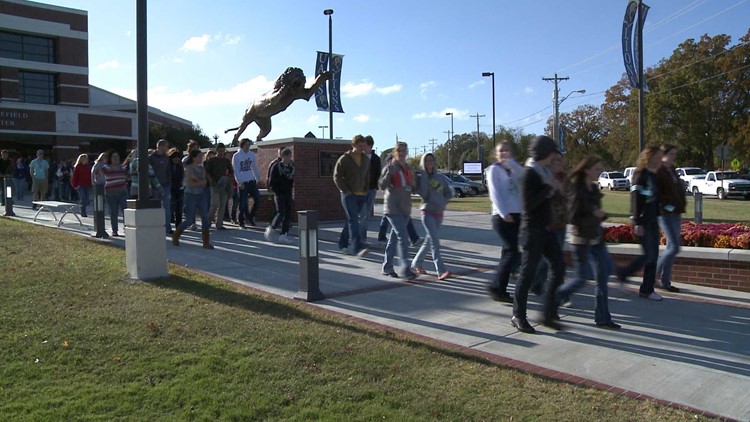(CNN) — Latino student populations have been on an upward trajectory in the U.S. for decades, and a report released Monday says the group’s growth reached record levels last year, both in public schools and colleges.
The number of 18- to 24-year-old Latinos in college topped 2 million in 2011, accounting for 16.5% of all enrollments, according to a report by the Pew Hispanic Center. The number means Latino representation in U.S. colleges and universities is on par with the percentage of Latinos among the U.S. population, also 16.5%.
Record numbers of Latinos are also finishing college, with 112,000 earning associate degrees and 140,000 earning bachelor’s degrees. Pew states both statistics are new highs, yet Latinos still lag behind whites (1.2 million bachelor’s degrees and 553,000 associates) and blacks (165,000 bachelor’s and 114,000 associates) in degree attainment.
“Some of the growth in Hispanic college enrollments simply reflects continued growth in the nation’s Hispanic population – since 1972, the number of Hispanic 18- to 24-year-olds has grown nearly five-fold, rising from 1.3 million then to 6 million in 2011,” the report said.
However, population alone cannot explain the numbers, as eligibility to attend college also is a factor. In 2011, 76% of Latinos age 18 to 24 had completed high school, another record and a 3.5% improvement over 2010 numbers.
At the pre-kindergarten-through-12th-grade level, Latinos made up 23.9% of students in 2011, another record, according to the report from the nonpartisan Washington-based think tank.
To break the 2011 numbers down further, Latinos made up 26% of the country’s nursery school and kindergarten students, 25% of elementary school students and 21% of high school students, the report states.
The number is primed to continue increasing for the next two decades, with the U.S. Census Bureau forecasting that Latinos will make up a third of the nation’s 3- to 17-year-old children by 2036.
The numbers confirm Latinos as the largest minority group on American campuses, and they show what appears to be a growing divide between Latino students and their African-American counterparts.
Black college enrollment in 2011 was down 3% from 2010, dropping from 1.69 million to 1.64 million, while Latino enrollment was up 15%, from 1.81 million to 2.08 million. At four-year colleges, Latino enrollment jumped from 1 million in 2010 to 1.2 million in 2011, while black enrollment held steady at 1.1 million.
While the numbers are records, according to Pew, Latino students have been outpacing blacks in some student population categories for years.
In 1975, 6.94 million adults who finished high school went to college. About 309,000 were Latino and 665,000 were black. Thirty years later, the overall number jumped to 10.83 million, with 1.22 million of them Latino and 1.3 million of them African-American.
Latinos first topped African-Americans in public school enrollment in 2001. Back then, the respective numbers were 8.82 million to 8.65 million. Today, the number is 12.45 million to 8.27 million, according to Pew.
And while there’s a starkly lower dropout rate among African-American youngsters (399,000, or 9%, of all students in 2011) than Latinos (975,000, or 16.3%, of all students), Latinos have been sending more kids to college for the last two years as well.
Some other figures from the report:
The number of white students in college jumped 3% between 2010 and 2011, from 7.66 million to 7.88 million. Meanwhile, the Asian student population plummeted 8%, from 811,000 to 748,000, in that same time.
While Latinos make up 25% of the public elementary school rolls, compared to blacks, who compose 14%, the numbers are closer once kids move to high school: Latinos 21% and blacks 16%.
There were 2.1 million Latino students in U.S. colleges last year, a 15% increase over 2010. The number increased 24% the year before. Latino enrollment made up 74% of the growth in total enrollments last year.
Last year marked the first time more Latinos than blacks enrolled at U.S. colleges and universities, but they have outnumbered blacks at two-year colleges since 2010.
Whites still rank No. 1 in high school completion, with at least 86% for the last 20 years, but Latinos and African-Americans are both closing the gap. While 88.3% of whites completed high school in 2011, 76.3% of Latinos and 81.4% of blacks could make the same claim. In 1993, the gap was far greater among whites (86.8%), Latinos (60.9%) and blacks (74.9%).
Despite a student population almost triple that of Hispanics, whites had a similar number of dropouts last year: 1 million out of 17.63 million white students and 975,000 out of 5.97 million Latino students.
With 1.72 million degrees (68.83% of all those conferred), whites earned more than twice as many bachelor’s and associate degrees as the other three groups combined – blacks (278,749 or 11.15%), Latinos (252,527 or 10.1%) and Asians (161,443 or 6.5%) – according to 2010 statistics. Whites, of course, make up roughly 72% of the U.S. population, compared with Latinos (about 16%) blacks (about 13%) and Asians (about 5%).
The Pew Hispanic Center report was put together using data from the U.S. Census Bureau and the U.S. Department of Education’s Digest of Education Statistics.
The-CNN-Wire/Atlanta™ & © 2012 Cable News Network, Inc., a Time Warner Company. All rights reserved.



